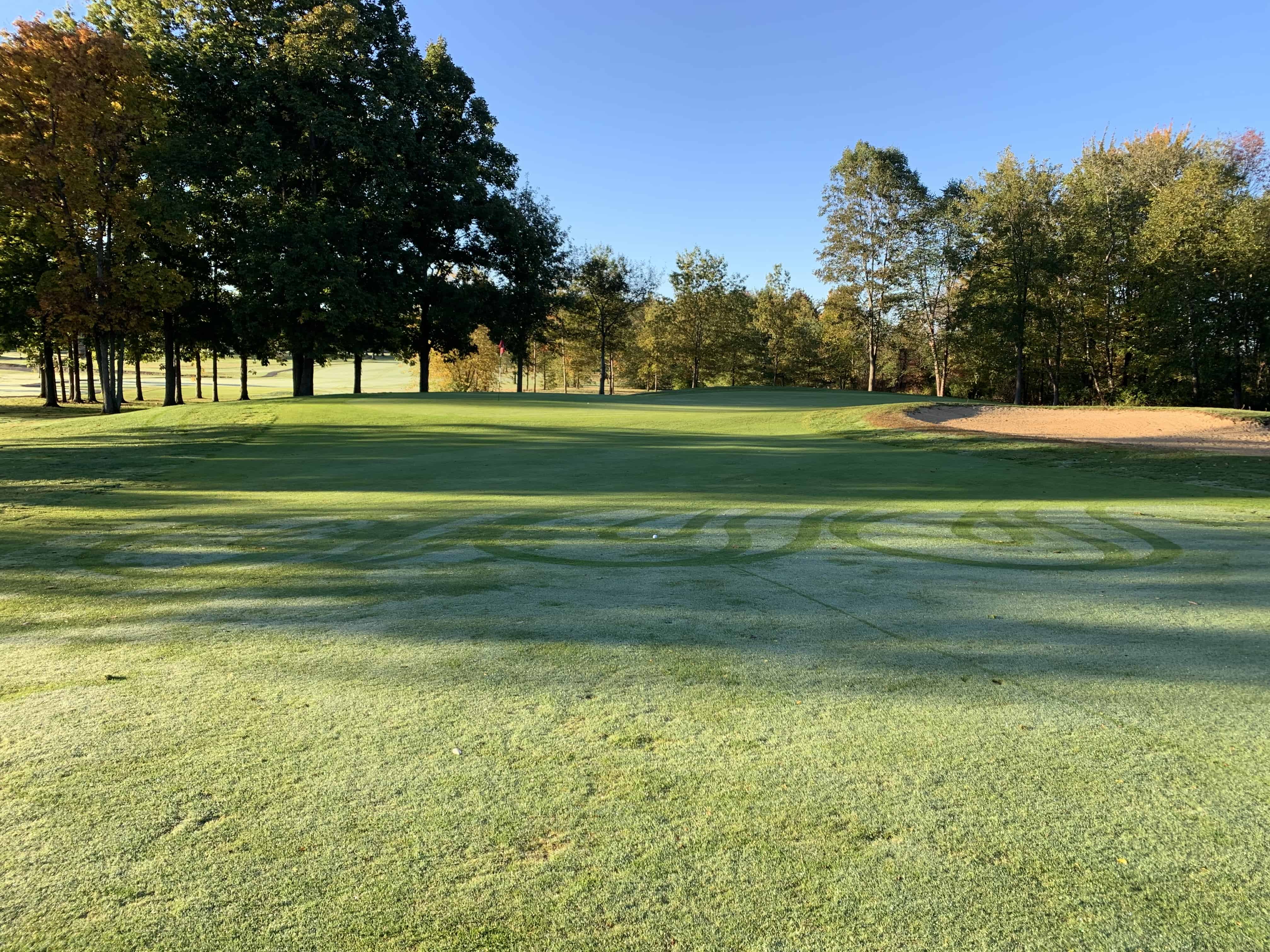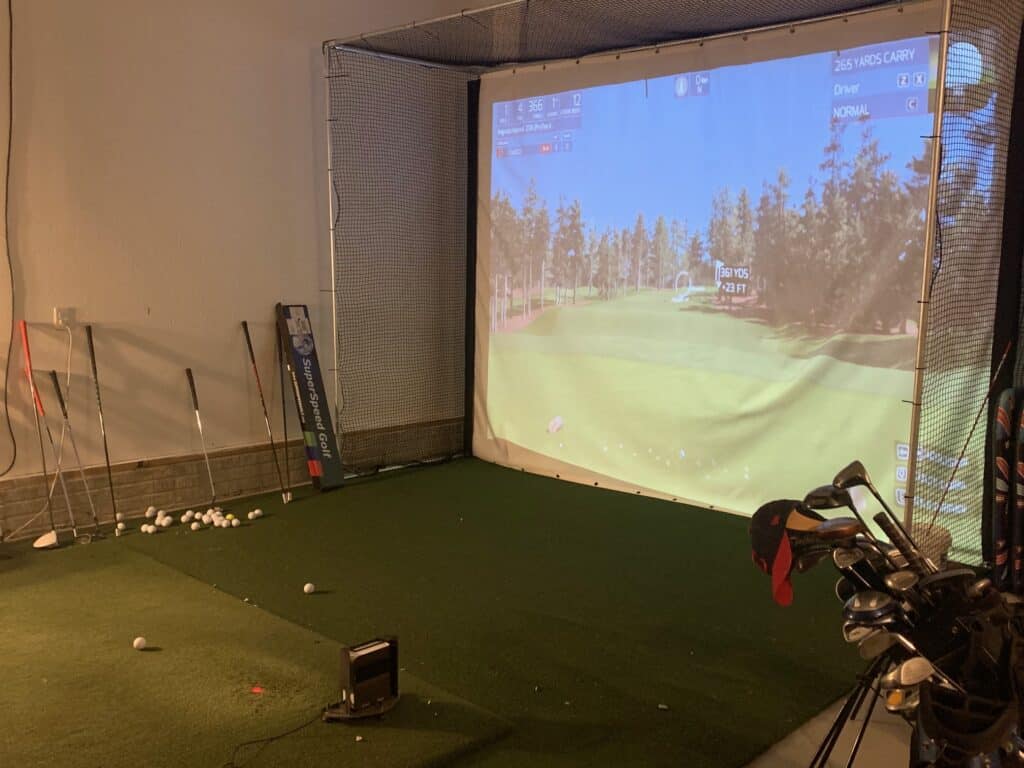Are you frustrated with your driver?
No matter what you seem to do the ball ends up somewhere other than the fairway?
Golf can become a frustrating game, but we are here to help.
I am going to take you through 5 steps of things to do and some basic understandings to help you hit more fairways, leading to more greens in regulation and better scores!
The driver is an important club in the bag, both from an accuracy perspective and the vitalness of having some distance. Golf courses are too difficult to be hitting long irons all day, hoping you can hold a green with your 3, 4 or 5 iron or even a hybrid.
The driver is essential and we are here to help out!

Why Can’t I Hit My Driver Straight
Technically speaking, your club face and your swing bath have too large of a gap between them. This causes an over curve of the golf ball or the ball never starts on the intended target line. Understanding some basic ball flight laws will lead to making adjustments that actually help!
Below, I will cover the following topics or steps related to key questions, “Why Can’t I Hit My Driver Straight”
- Basic Understanding of Ball Flight Laws
- How to complete an assessment to understand shot patterns
- Is your equipment setup properly for you?
- What adjustments can you make?
- The importance of a stock shot in golf
Step 1: Basic Understanding of Ball Flight Laws
For many years, there was some confusion over what causes a golf ball to start on a specific line and then curve relative to that line. Many thought that the path controlled the start line and the club face controlled the curve. When in reality, the opposite is true.
For the most part, the ball will start in the direction of the clubface at impact. So if the club is 3 degrees open or the right, the ball still starts right. The ball will then curve dependent on the relationship of the club face to the swing path.
To hit a straight shot, the golfer will need a square club face and a neural swing path. The perfectly straight shot in golf might be the most difficult shot to hit. That is why we recommend hitting either a slight draw or a slight fade. The margin of error is greater and it helps you develop a stock shot that is consistent and reliable.
For example, to hit a draw with any club (one that starts right and curves back towards the target), the golfer will want a club face that is slightly open at impact to get the ball to start right. However, the club face will be closed to the swing path, which means the swing path is further right than the club face.
To hit a fade with any club (one that starts left and curves back towards the target), the golfer will want a club face that is slightly closed at impact to get to the ball start left. However, the club face will be open to the path, which means the swing path is further left than the club face.
If either of these differences between club face direction and swing path direction becomes a wide gap in numbers, the golfer will struggle either with a slice or a hook. The goal is to maintain a 2-3 degree difference in clubface and swing path alignment. This is opposed to trying to swing perfectly square with a square path. This plan leads to some shots that will curve left and others that will curve right. Remember, our ultimate goal is a stock shot that starts on a general start line and curves back towards the target.
Resource: Ball Flight Laws (Complete Overview!)
Example 1:
Club Face – 2 degrees open (or to the right)
Swing Path – 4 degree to the right
The ball will start right and curve left, or back towards the target line.
Example 2:
Club Face – 3 degrees open (or to the right)
Swing Path – 1 degree to the right
The ball will start right and fade away from the target. This would be a push fade.
Example 3:
Club Face – 3 degrees closed (or to the left)
Swing Path – 4 degrees to the left
The ball will start left and fade back towards the target.
In Summary, the ball will start in the relative direction that the club face is facing at impact and then curve away from the swing path. To hit a draw, you need a face that is slightly open with a swing path slightly right of the club face. The opposite is true for a fade shot.
Step 2: How to complete an assessment to understand shot patterns
What is the general direction of your shot pattern with a driver. Here are some potential shot patterns:
- Ball starts right and curves right
- Ball starts right and curves left
- Ball starts left and curves left
- Ball starts left and curves right
- Ball starts right and flies straight
- Ball starts left and flies straight
Some of these options above you can live with, until the curve becomes too large. This is when there is too large of a gap in the difference between the clubface and the relationship to the swing path.
Resource: How to hit a draw with your driver (5 keys)
Here is an assessment you can complete:
- Hit 20 drivers at the driving range
- After every shot, mark on a chart, with the categories above on the chart, what flight pattern your ball followed.
- Over the 20 shots, what patterns do you notice?
- Inconclusive can be an option as well and maybe there are no patterns and you have the greatest level of inconsistencies!
Step 3: Is your equipment setup properly for you?
If you don’t have a pattern that you can establish or one that you are fine with, then the first step after the assessment is to determine if you have the right club for you or the right club setup. Many drivers come with the ability to adjust the loft and where some of the weight sits on the clubhead. Some items to consider:
- Do you have the right loft?
- Do you have the weight in the right spot?
- Is your golf shaft the right firmness?
If you have an adjustable driver, go ahead and make some adjustments. If you are hitting a regular flex shaft, yet swing over 100 miles per hour, you might have to whippy of a shaft for your speed of golf swing. A new golf shaft might be what you needed.
If you are losing swing speed and swing below 100 maybe it is time to move to a regular shaft or if you are now swing below 85, it might be time to consider a senior shaft.
Resource: How to increase driver swing speed

Step 4: What adjustments can you make?
Now that you have a basic understanding of the ball flight laws and how to read your own ball flight, it is time to make some adjustments. Many of these adjustments can be made prior to actually swinging the golf club. One of our top rated instructors, Shawn Clement, makes many adjustments in the setup to help produce a certain swing path and club face direction at impact. These pre shot adjustments give you a chance of setting yourself up favorable to produce the shot that you need.
Here are some adjustments you can test out:
- If you slice the ball, try closing your stance slightly and swinging along your stance line
- If you over draw the ball, try opening your club face slightly at address.
- If you want to hit a fade, slightly open your stance and swing along your stance line.
- If you hook the ball, try getting your path to go more left by opening your stance slightly at address.
- Test out your different adjustments with both stance and club face direction in the setup. Experiment and see what the reaction to the golf ball is. This will help you build a foundation of what causes certain shots.
Here is a quality Shawn Clement video on hitting a draw or fade:
Step 5: The importance of a stock shot in golf
The stock shot in golf gives you the ability to have a consistent shot that starts on a specific start line and then curves towards the target. You will find the best golfers around, often hit a stock draw or a stock fade. They have a go to shot for pressure situations and for every hole that they play. Some always hit the ball one direction, while others will vary depending on the golf hole.
We all want drills and I believe the best way to learn how to hit a straight shot with your driver or to practice the consistency that we all seeks is the stock shot drill below:
- At the driving range, place an alignment stick down the target line about 6 yards in front of you.
- Take a 2nd alignment stick and play it 2-3 yards to the left (fade) or the right (draw).
- Go ahead and try to hit 10 balls through this gate created by the alignment stick.
- How many times were you successful?
- Once you can get the ball started in your gate, this means you can control the start line of your shot.
- Now, note the direction the ball curves. Does it curve back towards the target?
- If not, make some setup adjustments with your stance or club face direction.
Resource: What is a stock shot and how to develop one!
BONUS: Technology Recommendation
One of the great things about playing golf in this era is the ability to have real time feedback and a shot tracer on every shot that you hit during your practice sessions. The key recommendation here is a portable launch monitor. While many won’t want to spend the money on a Trackman, there are some viable options int he 500 to 2000 dollars range that provide the following data after every shot:
- Ball Speed
- Spin Rate
- Spin Axis
- Launch Angle
- Carry and Total Distance
What I find most helpful is the shot tracer and the spin axis information. I am visually able to check the flight of my ball as I work to build my stock shot and have the reliable shot I can count on in any situation.
Here are the top 3 options to check out:
This technology is a game changer as the golfer can build a stock shot using the information while expanding a golf season where the golfer can practice 365 days a year. Whether the golfer goes all out and builds a home simulator or simply sets up a net and mat in their garage, the possibility of improving the swing and being able to practice of play 365 days a year is a game changer!
I went with the SykTrak and have been thrilled with the performance of this device and the improvement in my game!
Resource: SkyTrak Launch Monitor: The Ultimate Game Improvement Tool!

BONUS TIP: Gain More Speed
While everyone wants to be more consistent with their shot pattern and hit their driver straighter, we all want more distances as well.
The best product I have found on the market is the SuperSpeed Golf System. This three club system, which varies in weight, helps the golfer use an overspeed approach to gaining 5-8% in swing speed as early as the first training session. This speed becomes more permanent after 30 days of training. The training sessions only take place every other day and take about 15 minutes.
Check current price on SuperSpeed Golf, here!
The speed is real and the results are real. There is a good reason many of the touring pros, including Phil Mickelson, can be found using these on the driving range of every tournament. The challenge is fun and the distance is rewarding!
I have gained 7-10 miles per hour in my swing through training with SuperSpeed Golf. This has helped every club in the bag and my next goal is to reach the tour average of 113. I have gone from 98-101 on average to 106-109 on average. I am confident I can reach 113 in the coming months!
Take Action – What You Can Do Today to Get Better
What does this mean for you? I believe in the following recipe to get better:
1 – Improve your motion in the golf swing by identifying a golf instructor. Here are some options:
Here is a list of golf instructors that we have reviewed:
2 – Train to swing faster and improve your swing speed. Here are some options:
Looking to gain more Speed and Distance in your swing. Two Options:
3 – Understand course strategy and work to break through your next barrier. Here is a series on breaking through:
We have provided guides on how to break 100, 90, 80 and 70. Check out more below, if interested.
4 – Practice Frequently
Did you know that I build a golf simulator in my garage and have played over 500 rounds of golf on my SkyTrak system? It has been a game changer and one worth checking out. Here are some of my other posts on golf simulators frequently asked questions:
- Is a Golf Simulator Worth It?
- How to Build a Golf Simulator?
- What is the Best Golf Simulator?
- Golf Simulator Accessories?
- How to Build a Golf Simulator for under $7000
- Top 11 Reasons to Buy a SkyTrak
- How to Build a Golf Simulator for Under $1000
- Why Build A Golf Simulator?
- What Space is Needed?
- Can A Golf Simulator Improve My Game?
- How Much Does A Golf Simulator Cost?
- Don’t Forget to Check out our 15 best golf swings of all time.
I am an amateur golfer on a journey to get better, enjoy the game as often as possible and share my passion and knowledge with others. I have coached high school golfers at a high level and have a great passion for the game and want to give back. I enjoy learning about the golf swing and am currently studying to be a certified professional golf instructor. Join me in our journey to get better everyday. Thank you for reading!

